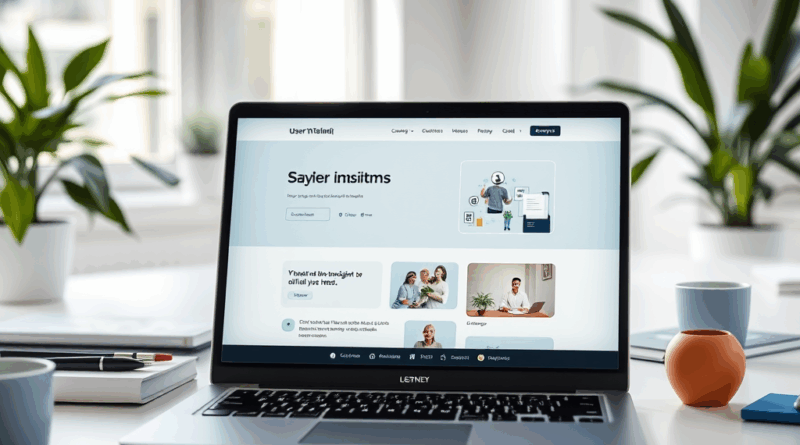Improving Website User Experience (UX)
In today’s fast-paced digital landscape, where attention spans are shorter than ever, the importance of user experience (UX) cannot be overstated. The way users interact with a website determines not just their immediate satisfaction, but their long-term relationship with a brand. Essentially, a stunning design is invaluable if users struggle to navigate or engage with the content. Companies that prioritize UX often find themselves reaping the benefits of increased engagement and conversion rates. The journey towards optimizing website user experience is multifaceted, requiring a keen understanding of user behavior and preferences. This article explores critical elements and strategies that can help transform your website into a user-friendly digital haven.
Understanding User Experience (UX)

User Experience (UX) represents the feelings and attitudes that users have while interacting with a website. It’s a holistic concept encompassing factors such as design, usability, accessibility, and even emotional tones. A positive UX ensures that users feel valued, understood, and satisfied. On the other hand, a negative experience can lead to frustration, abandonment, and a tarnished brand image. The impact of UX goes beyond just aesthetic appeal; it’s about creating a seamless journey that guides users effortlessly toward their goals. By cultivating a great user experience, brands can foster loyalty and trust, which are invaluable assets in a highly competitive digital marketplace.
Effective UX design greatly influences key performance metrics that determine the success of digital marketing efforts. Almost every interaction a user has with a website becomes part of their experience—be it through a call-to-action (CTA), accessing content, or navigating through sections. Websites with exceptional UX often see higher customer retention rates, as users are more likely to return to a site that meets their needs and expectations. This ultimately drives organic traffic, improves conversion rates, and boosts search engine rankings, leading to a virtuous cycle of growth. To maximize digital marketing ROI, businesses must successfully align their UX design with various marketing strategies. A user-centric approach fosters a positive perception of the brand and enhances the likelihood of recommendations.
Key Elements of User Experience Design

When it comes to optimizing user experience, a few key elements stand out as critical. These foundational components serve as the building blocks for a website that qualifies as user-friendly and accessible. Below are some of the essential elements that contribute to an exemplary UX.
Website Navigation
Website navigation is perhaps the most vital aspect of UX design, guiding users seamlessly through the different sections of your site. A poorly constructed navigation can lead to user confusion, resulting in high bounce rates. Here are some best practices to ensure effective navigation:
- Use clear and descriptive labels for menu items.
- Implement a simple layout that doesn’t overwhelm users.
- Prioritize key pages by placing them at the top level of the navigation menu.
- Include a search bar to facilitate quick access to specific content.
Mobile Responsiveness
As the number of mobile Internet users continues to rise, ensuring your site is mobile-responsive is no longer optional; it’s a necessity. Mobile responsiveness involves adapting your website’s layout and elements to work seamlessly on various mobile devices. Below are major advantages of having a mobile-friendly website:
- Improved user engagement and satisfaction.
- Higher chances of conversion due to easier access.
- Enhanced visibility in search engine rankings for mobile searches.
- Access to a wider audience on various devices.
| Element | Importance | Best Practices |
|---|---|---|
| Navigation | Guides User Journey | Clear Labels, Search Function |
| Mobile Responsiveness | Accessibility on Devices | Fluid Grids, Media Queries |
| Page Load Speed | Affects Engagement | Image Optimization, Minimize HTML/CSS/JS |
Page load speed is another critical element that greatly affects user experience. Studies show that even a slight delay in loading time can lead to increased bounce rates and decreased conversions. Websites must employ various optimization techniques to improve loading times, which not only successfully retains user interest but also enhances SEO performance.
Strategies for Enhancing User Experience
Implementing focused strategies can result in significant improvements to the overall user experience. Each approach must be tailored to fulfill user needs while aligning with the brand’s objectives. Below are several effective strategies that can yield positive results.
User-Centered Design Approach
Employing a user-centered design approach ensures that the users’ needs and preferences are the primary focus throughout the design process. Involving user personas and conducting usability testing allows designers to make informed choices rooted in actual user behavior. This method enhances usability and fosters a sense of ownership among users, resulting in design choices that resonate more effectively.
Consistent Branding
Maintaining consistent branding across your website is essential for building user trust and recognition. Whether it’s through the logo, color schemes, or tone of voice, cohesive branding creates a unified brand image. Users tend to gravitate towards brands that present a professional and reliable appearance. A consistent look and feel make it easier for users to navigate and find the information they need without feeling lost.
Clear Call-to-Action (CTA)
Clear CTAs play a critical role in guiding users towards desired actions, whether it be signing up for a newsletter, making a purchase, or downloading an eBook. Effective CTAs should be visually distinct, concise, and persuasive. Place them strategically throughout the site to encourage engagement at pivotal moments in the user journey. Experiment with language and design to discover what resonates best with your target audience.
Conclusion
Improving website user experience is an ongoing endeavor that requires commitment and adaptability. By prioritizing user needs and strategically implementing design optimizations, businesses can enhance engagement, boost conversions, and create lasting relationships with their audience. It’s essential to continually refine the elements of your website based on user feedback and analytical data to stay aligned with changing user expectations. Ultimately, a well-designed user experience not only benefits your customers but is a smart investment for your brand’s future growth.
Frequently Asked Questions
- What is User Experience (UX)? UX refers to the overall experience a user has when interacting with a website, including design, usability, and accessibility.
- Why is UX important for my website? A good UX improves user satisfaction, increases engagement, and can lead to higher conversion rates and customer loyalty.
- How can I improve my website’s navigation? Use clear labels, a simple layout, and a logical hierarchical structure to help users find what they need quickly.
- What are the best practices for mobile responsiveness? Utilize responsive design techniques, optimize images, and ensure touch elements are appropriately sized for mobile interaction.
- How do I measure my website’s user experience? Use analytics tools to monitor user behavior, conduct surveys for direct feedback, and analyze metrics such as bounce rates and session duration.
